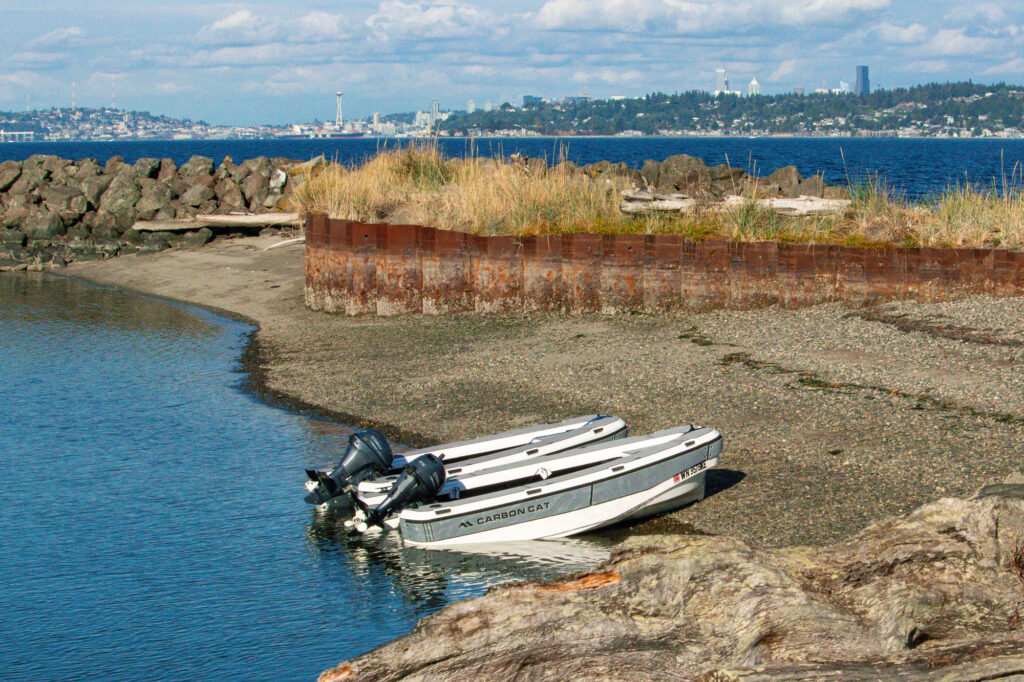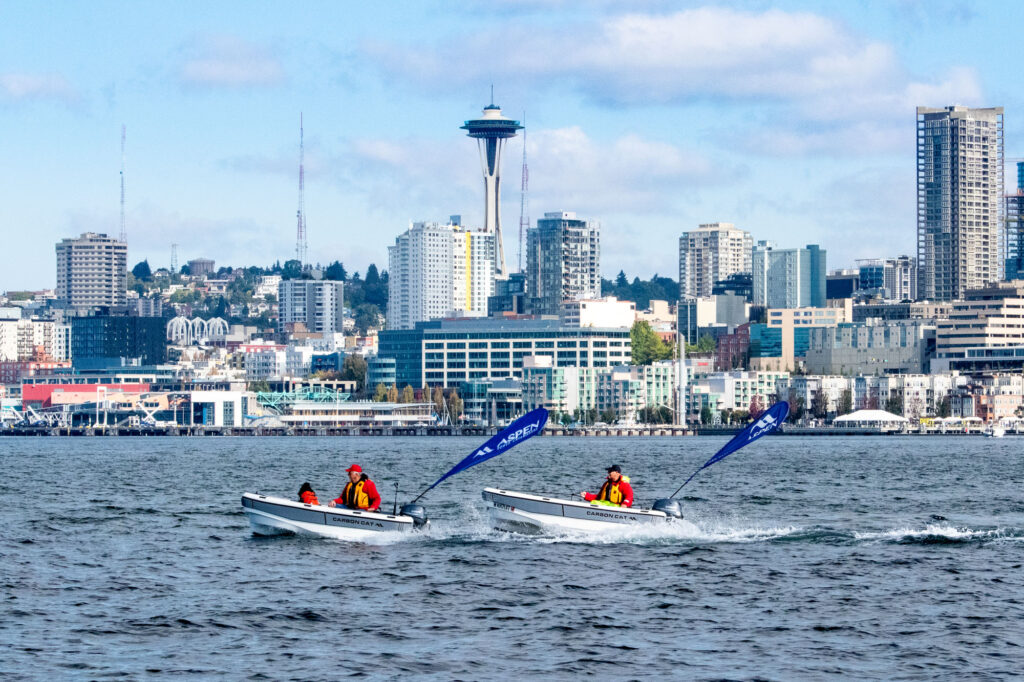
By Ron Parker / Photos Courtesy of Aspen Carbon Cat
Necessity is often the mother of invention, and such could be said about the creation of the Aspen Carbon Cat.
Local boat builder and adventurer Larry Graf, founder of the Burlington-based Aspen Power Catamarans, was inspired after realizing that he and other Aspen owners were often frustrated by typical RIB (Rigid Inflatable Boat) tenders. The size of the RIB often meant wasting otherwise usable space, the tubes were slippery when boarding, and the boats have a limited lifetime, meaning expensive tenders eventually either need to be retubed or replaced. Larry knew what he wanted—an efficient, hard-bottom tender that was lightweight, stable, and durable.
So, he got to work on his own design: the Carbon Cat. Valuing the stability and performance of Aspen catamarans, his first move was to keep the twin hull surfaces aft on the new tender, but as he refined the design, he included a fine entry forward to cleave the water and keep the ride soft and the boat dry. This hull shape also allows for a smooth and level interior floor to provide additional comfort. The hybrid hull is crafted from the same high-tech materials and composites as those used in the aerospace industry: carbon fiber E glass and pure vinyl ester resin combined with Divenacell core sections that make the boats both light and remarkably strong. Other innovative features include a cushioned seating cube that can be used for rowing or motoring; premium removable Rail Blaze running lights; integrated oarlocks; 3” EVA interior hull side flotation for buoyancy; and versatile Burnewiin adapters that can house rod holders, cleats, and more.
Currently available in three sizes—the 9’2” T9, the 10’2” T10, and 11’2” T11—the Carbon Cat models were tested to meet or exceed USCG requirements for level flotation and stability, which include pulling the drain plugs and air chambers, loading them with 320 pounds of concrete weights, and filling them with water to ensure they still float. Not only are the boats remarkably stable, they are fast and fuel efficient. After spending the summer of 2023 cruising aboard his 32’ Aspen with a Carbon Cat in tow, Larry was impressed with how the Cat performed as a tender carrying people, supplies, and equipment, but he wanted to really test the Cat’s mettle.
Thus, in late September 2023, Graf, his dog Daisy, and friend Dale Dahl set out in a pair of Carbon Cats for a multi-day, 188-mile-long trip around Puget Sound.
Graf’s T10 cruised out of Anacortes powered by a 9.9hp outboard, and Dahl manned his T11 with a 15hp Yamaha running alongside Graf’s smaller tender. The forecast was for calm, but after exiting the Rosario Strait, they encountered building wind and seas in the eastern part of the Strait of Juan De Fuca. After 15 miles exposed to the Strait, they hoped things would temper down as they neared Port Townsend, but with 20-knot winds against the heavy currents coming out of Admiralty Inlet, they found themselves powering into short, steep chop. It wasn’t the easiest as they ran through waves and currents, but the Carbon Cats remained dry and seaworthy. They stopped in Port Ludlow that first night after an exhilarating 45-mile journey.
The next day they continued farther into Puget Sound, enjoying the morning’s relative calm as they rounded Point No Point. Later in the day as they skirted the eastern shore of Bainbridge Island, the wind piped up out of the north gusting to 28 mph, but Graf said the Carbon Cat’s design worked well in these real-world conditions. Speeds slowed to about 14, but the boats stayed on plane with only occasional spray. After another day of open-air cruising, they careened the boats in the sand on the lee side of Blake Island for their second night. The optional Beachmaster fold-down transom wheels allowed the boats to easily roll up the beach and above the tideline. After a nice night at the state park, the trio cruised past Alki, across Elliott Bay with the Space Needle and city as a backdrop, before rounding Magnolia and coming into Shilshole to refuel. Graf and his dog Daisy had only used around 6.6 gallons in the approximately 75 miles completed so far, and the larger T11 that Dahl ran only used 7.2 gallons, remarkably little fuel for this type of cruising. The boats are quick (18-21 mph) when running in good conditions, but with higher winds, waves, and currents they cruised at a still very respectable 12-14 mph on average. After checking in with Northwest Yachting’s own Craig Perry during the pit stop, the Carbon Cats shoved off and headed north. Afternoon conditions were tough as they battled through more wind and waves before the seas finally calmed down around Mukilteo. They had a nice run up the Saratoga Passage into LaConner, and through the Swinomish Channel for their return to Anacortes.
Their journey proved exciting and productive. The weather was less than ideal, but the idea was to have an adventure and to see how the Carbon Cats held up on a trip that most people would never attempt in a tender. Graf thinks he’s more than proved that these little boats can perform safely and effectively, even on a trip normally reserved for larger, more substantial vessels. After completing the trip, he reflected: “We have gone through stuff no one goes through with a dinghy, and still managed to have a lot of fun!” Even Daisy seemed unfazed by the sea adventure, although the team did admit she seemed pretty happy to be back at the dock and to her usual doggie bed.
>> For more information on Aspen’s Carbon Cat tenders, go to: aspencarboncat.com.



